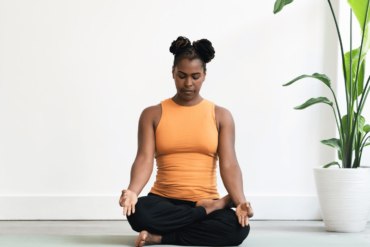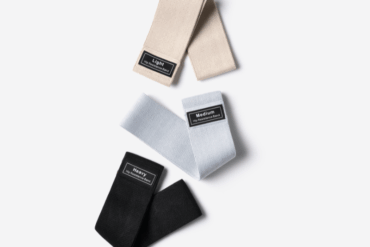Below I have selected five postures that support regulating the nervous system, facilitating an expansive inner dialogue and, hopefully, quieting the mind in preparation for meditation. Depending on how your body feels in the moment, if you have any (old) injuries or if you’re holding these postures for longer, like I tend to, it can make sense to use props to provide support and space to genuinely deepen or relax into the posture.
Supta Vīrāsana
I used to consider this posture my nemesis (one of many). I’ve befriended it now.
Supta Vīrāsana, often translated as reclining hero pose, is excellent for relieving indigestion, releasing lower backaches and stretching the knees. The variation pictured is less strenuous than lying flat on the floor. If you want a deeper stretch of the legs and abdomen, you can remove the blocks and simply use a bolster and a blanket.
Practice the āsana at the beginning of your session, as it calms a restless and agitated mind. But that calm might not come initially. The aches and pains of the knees, lower back and abdomen might all decide to begin talking very loudly at once.
Take your time reclining into the posture as well as coming out of it. When you begin to rise, be sure to lift the head as the very last thing you do, so that you’re not gripping in the neck region. Bring the legs forward into dandāsana and breathe. Nothing else is required.
Supta Baddhakonāsana
If you only have 10 minutes to practice at home, this is your āsana.
The Sanskrit word supta means “reclining”, baddha means “fixed”or “bound”, and kona translates as “angle”. This is a restful posture that can be practiced by most anyone without concern.
You can rest over a bolster or flat on the floor, as I have in the image. The belt helps keep the legs in position because the feet are less likely to slip. You can use support under the thighs to reduce strain in the groin region. Thus, those muscles begin to release toward the knees, and the knees are then able to release toward the floor. Let gravity do the work for you.
The eye mask is useful to help keep the eyes passive. You can use a mudra to help keep the mind focused, or you can take the hands to either side of the body and fully relax.
Adhomukha Vīrāsana
Adhomukha Vīrāsana, often translated as downward-facing hero pose, is a restful posture that you can repeatedly come back to throughout your practice.
Once the head comes to rest on the floor, the frontal brain is able to rest, which can reduce stress and calm the mind. However, don’t lift the buttocks from the heels in order to force the head down. Instead, bring the floor to you. Take a bolster lengthwise between the knees and roll a blanket, so that the forehead can rest comfortably. You can roll a second blanket and place it between your buttocks and lower legs.
What you might not see clearly in the image is that my big toes are touching, and my knees are spread wide enough, so that my outer ribs can rest on the thighs. This gives me more room to breathe freely through the abdomen.
Śavāsana
Śavāsana, or corpse pose, is highly underestimated as a posture. Often, people mindlessly lie down, spending the end of their yoga session already thinking about their to-do list and missing out on the magic of this restful yet invigorating posture.
Allow yourself at least five minutes in this posture. Can you practice an outer stillness while remaining alert to the sensations and energy flowing through your body? If your practice included intense bends – forward or back – then it could be useful to take support under the knees or lower legs. Once the lower back has released any tension it may have been holding, you can remove the support. Keep your breathing smooth and free of tension but don’t force deep breathing.
When you come out of the posture, take your time. Try not to bring tension to the neck and throat region. It can be helpful to roll to one side and pause there, before lifting yourself up into an upright seated position.
Ardha Padmāsana
Padma is a lotus. Padmāsana is therefore translated as lotus pose. For people not used to sitting on the floor, it can feel quite uncomfortable to sit in this posture for an extended period of time. Half lotus, or adha padmāsana is your route in.
Padmāsana is an important posture for meditation and prāṇāyāma, both of which are negatively affected by a slouching posture (e.g., hardening in the lower back, rolling the shoulders forward, hunching at the middle back). With this āsana, the body more easily aligns along the natural curve of the spine which allows the breath and energy to flow.
Give this a try for even just a few seconds, and you’ll notice the gentle stretch it offers in the hips and glutes. You can also try simply sitting on the floor from time to time to build to this posture. If this posture is not an option for you, sitting in a chair with a high back, both feet parallel and evenly pressed into the floor is a great alternative to maintain the integrity of an upright seated position.
Find out more about Stacie CC Graham
Website: https://stacieccgraham.com/
OYA Retreats: https://www.oyaretreats.com/
Instagram: @oyaretreats
The post 5 Poses for Regulating the Nervous System appeared first on Blog – Yogamatters.



